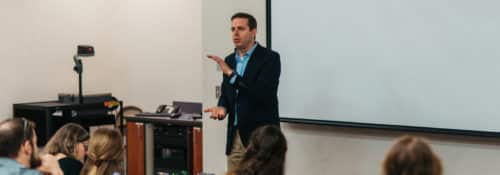
Dr. Coupland’s Six Fundamentals of Good Instruction
Dr. Daniel Coupland is chairman and professor of education at Hillsdale College. At the Barney Charter School Initiative summer teacher training, he gave a  lecture summarizing years of research on teaching into what he calls the “Six Fundamentals of Good Instruction.”
lecture summarizing years of research on teaching into what he calls the “Six Fundamentals of Good Instruction.”
- Manage the Classroom: Your students want to know where the parameters are and expect you to make them, Coupland says. “If you don’t tell them, they are going to go looking for them.”
- Reduce Students’ Cognitive Load: Classical education does not simply mean more work. “It might actually mean less,” Coupland says. “The idea is to get things from the short-term memory into the long-term memory.” By teaching less, but presenting the information in chunks or relating it to previous knowledge, teachers can communicate ideas memorably and in a way that doesn’t overwhelm students’ short-term memory.
- Be Involved: Even while students are working independently, Coupland advises walking around the classroom and working with students individually.
- Check for Understanding: This could be anything from requiring students to write a long, formal essay to checking if students are nodding their heads. “We need to be frequently checking to see whether our students are actually following along with us,” Coupland says. For example, he suggests stopping the lecture every so often and telling students to write down three things they learned in the past 20 minutes.
- Provide Meaningful Feedback: Coupland quotes Dylan William, an assessment expert, who suggests teachers write longer, more meaningful comments on only 25 percent of students’ work. In the other 75 percent of homework, teachers should quickly review and check for recurring errors. This way, the teachers have more time to plan good lessons and focus on the student rather than his work.
- Review: “Your lesson needs to be like a good paper,” Coupland says. “You need to have an introduction, a body, and a conclusion.” Both the introduction and conclusion, though, should review the most recent information and preview the forthcoming lesson. He suggests using assessments to review as well: “The Friday quiz or test or short pop quiz is a good way to review what you’ve done over the week. Review, review, review.”
Throughout his talk, Dr. Coupland emphasized the importance of empathy. The focus should be on the student. “When I was a high school teacher in a suburb just north of Detroit, every so often at the end of the day when I was completely exhausted, I would go out into the classroom and pick a chair to sit in, just for a few minutes,” Coupland recalls. “In fact, oftentimes I would pick the chair of a student who was really struggling in my class, just to see, ‘What does the classroom look like from his perspective?’ I’ll tell you, it’s quite an experience.”
By pairing these practical methods with a heart for students, teachers can share their love of the subject matter with their students. Coupland encourages students to heed these words of educator John Milton Gregory from 1886: “The steady advance of veterans is more powerful than the mad rush of raw recruits.”
Written by Avery Lacey, ’20